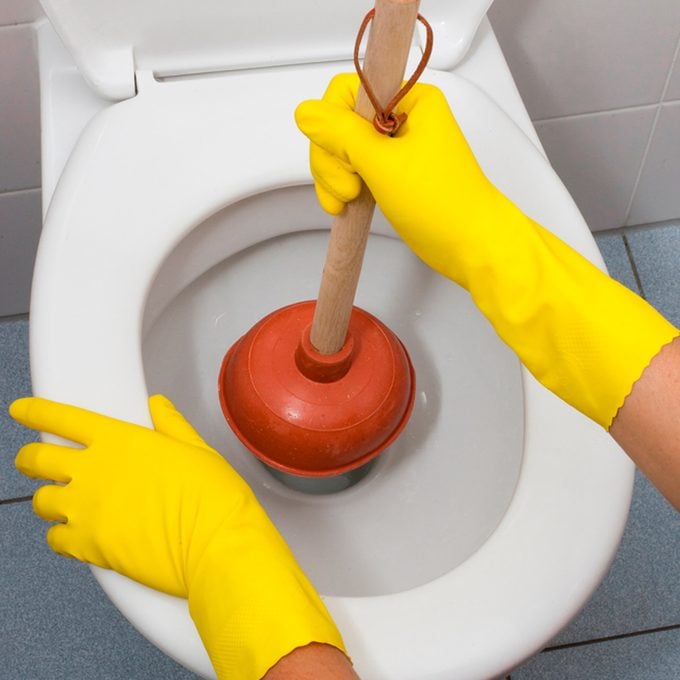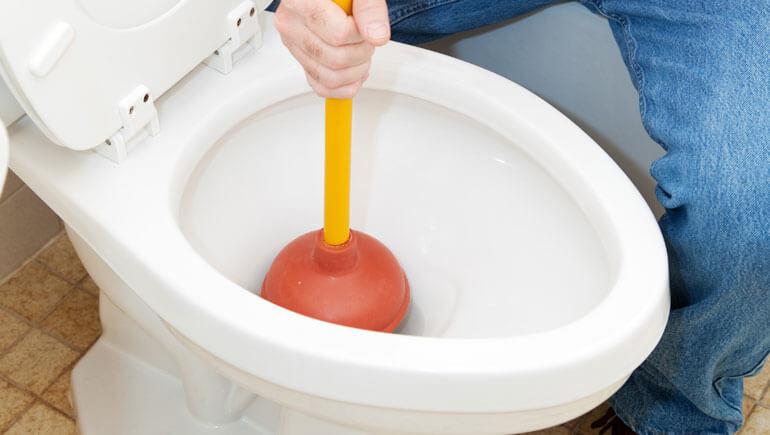We have stumbled upon this article about Here's How to Correctly Use a Toilet Plunger below on the internet and think it made good sense to share it with you over here.

Introduction
Appropriate upkeep of home drains pipes is essential for stopping obstructions and guaranteeing smooth water circulation. Among the trick tools in every property owner's toolkit is the bettor, alongside various drain cleaners created to take on persistent obstructions effectively. This article explores how to use plungers and drain cleaners effectively to maintain your drains pipes moving openly.
Area 1: Comprehending Plungers
Types of Plungers
There are several sorts of bettors offered, each designed for different kinds of drains pipes and blocks. One of the most usual kinds consist of cup plungers, flange plungers, and accordion plungers.
How Plungers Job
Plungers deal with the principle of creating stress and suction to displace blockages. When properly used over a drainpipe, they produce a vacuum that can take out debris or separate blockages.
Selecting the Right Bettor
Selecting the right bettor depends on the type of drain and the nature of the obstruction. Cup bettors are excellent for sinks and tubs, while flange plungers are much better suited for commodes because of their layout.
Typical Blunders with Bettors
Staying clear of these mistakes makes certain efficient plunging: inappropriate seal around the drain, not enough pressure, and not clearing surrounding particles.
Area 2: Using Plungers Successfully
Prep work
Prior to plunging, guarantee the bettor covers the drainpipe entirely and creates a tight seal. Clear any type of visible particles around the drain opening.
Strategy
Beginning with mild diving movements to construct suction. Rise pressure slowly, making use of a constant rhythm. Repeat as necessary until the drain removes.
Troubleshooting Tips
If plunging does not function, attempt readjusting the seal, applying oil jelly for a much better seal, or making use of a various sort of plunger.
Section 3: Understanding Drain Cleaners
Types of Drain Cleaning Company
Drain cleansers can be chemical or chemical. Chemical cleansers use strong chemicals to dissolve clogs, while enzymatic cleaners utilize natural enzymes to break down organic matter.
Just How Drain Cleansers Job
Chemical cleaners respond with blockages to dissolve them, while enzymatic cleaners break down natural products like hair and oil without harming pipelines.
Safety and security Factors to consider
Constantly put on handwear covers and eye security when using chemical drain cleansers. Make sure sufficient ventilation and adhere to manufacturer directions thoroughly.
Eco-Friendly Alternatives
Consider using vinegar and cooking soda or enzyme-based cleansers for eco-friendly alternatives that are much safer for pipelines and the atmosphere.
Section 4: Making Use Of Drain Cleaning Company Successfully
Application Techniques
Put chemical cleaners directly right into the drain opening. Enable them to work for the suggested time prior to flushing with hot water. Chemical cleansers should sit over night.
Precautions
Avoid mixing various sorts of cleaners, as this can create harmful fumes. Never ever make use of chemical cleaners along with a bettor, as spilling can take place.
Taking Care Of Persistent Obstructions
For relentless blockages, take into consideration utilizing a pipes snake or calling an expert plumber to stop damages to pipelines.
Final thought
In conclusion, understanding just how to utilize plungers and drainpipe cleaners effectively is important for keeping healthy and balanced plumbing systems. By picking the right tools and strategies, house owners can tackle small clogs and protect against major pipes issues down the line.
How To Properly Use A Plumbing Snake To Clear Drains
When any drain clogs in our home arise, we tend to gravitate toward the plunger and little else. In cases where the plunger and its vacuum-created pressure are not able to clear clogs, many immediately move to harmful chemicals or simply call their plumber to fix the issue.
we’re happy to help with all drain cleaning needs and concerns. This includes informing you on a few other home remedies you may have at your disposal for minor to moderate clogs, one of which is the use of a plumbing snake. Many people have never used one of these before – let’s go over the steps to take when your drain clogs and you have a plumbing snake available.
Attempt Plunger Use
The first step here, as we noted above, should indeed be to grab your plunger when you notice a drain clog and attempt to resolve it this way. If you’re unsure how to use a particular type of plunger, our plumbers can answer any questions you have. If this doesn’t do the trick, however, you move on to the snake.
Locate And Prepare Snake
A plumbing snake is a metal or plastic device that’s generally about a quarter of an inch thick. It’s design with significant extensions, meant to reach down into your clogged drain and push the clog out. Snakes also contain drain augers that will latch onto and push stubborn blockages.
If your plunger doesn’t clear a clog, locate your snake and bring it to the drain in question. We also recommend keeping a bucket nearby to collect the clog once you pull it out, plus we’d advise wearing goggles and possibly protective gloves.
Feed Snake
Once you’re ready to go, feed the snake slowly down the drain, using the crank device it comes with to keep it moving until it finds the clog. Once this happens, much of the clog will be latched onto the coil so you can pull it out, while the rest will simply break up and flow downward.
Detach Debris
Remove the snake slowly from the drain, and once you’ve done so, pick off any debris that’s stuck to the coil. This is another area where wearing gloves is a must.
Flush Drain
Finally, take a few minutes to ensure the snake has done its job correctly. If you’ve been using it on a toilet, flush the toilet a couple times and make sure everything flows well. If you’ve used it on a different drain, flush it with some room temperature water.
https://www.mybuddytheplumber.com/blog/how-to-properly-use-a-plumbing-snake-to-clear-drains/

Application Techniques
Put chemical cleaners directly right into the drain opening. Enable them to work for the suggested time prior to flushing with hot water. Chemical cleansers should sit over night.
Precautions
Avoid mixing various sorts of cleaners, as this can create harmful fumes. Never ever make use of chemical cleaners along with a bettor, as spilling can take place.
Taking Care Of Persistent Obstructions
For relentless blockages, take into consideration utilizing a pipes snake or calling an expert plumber to stop damages to pipelines.
Final thought
In conclusion, understanding just how to utilize plungers and drainpipe cleaners effectively is important for keeping healthy and balanced plumbing systems. By picking the right tools and strategies, house owners can tackle small clogs and protect against major pipes issues down the line.
How To Properly Use A Plumbing Snake To Clear Drains
When any drain clogs in our home arise, we tend to gravitate toward the plunger and little else. In cases where the plunger and its vacuum-created pressure are not able to clear clogs, many immediately move to harmful chemicals or simply call their plumber to fix the issue.
we’re happy to help with all drain cleaning needs and concerns. This includes informing you on a few other home remedies you may have at your disposal for minor to moderate clogs, one of which is the use of a plumbing snake. Many people have never used one of these before – let’s go over the steps to take when your drain clogs and you have a plumbing snake available.
Attempt Plunger Use
The first step here, as we noted above, should indeed be to grab your plunger when you notice a drain clog and attempt to resolve it this way. If you’re unsure how to use a particular type of plunger, our plumbers can answer any questions you have. If this doesn’t do the trick, however, you move on to the snake.
Locate And Prepare Snake
A plumbing snake is a metal or plastic device that’s generally about a quarter of an inch thick. It’s design with significant extensions, meant to reach down into your clogged drain and push the clog out. Snakes also contain drain augers that will latch onto and push stubborn blockages.
If your plunger doesn’t clear a clog, locate your snake and bring it to the drain in question. We also recommend keeping a bucket nearby to collect the clog once you pull it out, plus we’d advise wearing goggles and possibly protective gloves.
Feed Snake
Once you’re ready to go, feed the snake slowly down the drain, using the crank device it comes with to keep it moving until it finds the clog. Once this happens, much of the clog will be latched onto the coil so you can pull it out, while the rest will simply break up and flow downward.
Detach Debris
Remove the snake slowly from the drain, and once you’ve done so, pick off any debris that’s stuck to the coil. This is another area where wearing gloves is a must.
Flush Drain
Finally, take a few minutes to ensure the snake has done its job correctly. If you’ve been using it on a toilet, flush the toilet a couple times and make sure everything flows well. If you’ve used it on a different drain, flush it with some room temperature water.
https://www.mybuddytheplumber.com/blog/how-to-properly-use-a-plumbing-snake-to-clear-drains/

I am very intrigued by and I hope you liked the entry. Sharing is nice. Who knows, you may be helping someone out. Thanks for being here. Return soon.
Call Today